I tested out the Duolingo Romanian course for 30 days to see if it’s worth doing.
This Duolingo Romanian review will go into detail on whether I think it’s worth doing the Duolingo Romanian course as well as the positives & negatives of the course.
The review is broken up into different sections and I’ve gone into detail on how good Duolingo Romanian is in teaching you to speak, listen, read and write in Romanian.
Table of Contents
Summary
Here I’ve written a brief summary of my thoughts on the Duolingo Romanian course. After this summary, I have gone into much more detail into the course, what you’ll learn and more.
Good Things About Duolingo Romanian
- The course has audio clips for every word and phrase.
- You pick up pronunciation easily and quickly.
- They introduce relevant and useful words and phrases.
- Lots of opportunities to practice what you’ve learnt.
- The course builds on concepts you’ve already learnt whilst introducing new words as you go.
- It’s free.
Bad Things About Duolingo Romanian
- Virtually no speaking practice – the course mainly focuses on reading and writing.
- Explanations on grammar points include lots of jargon and sometimes are difficult to understand.
- Some lessons introduced too much new vocabulary at once which meant it was difficult to remember it all.
- Some grammar points could have been explained better. I occasionally had to go elsewhere to find explanations.
Would I Recommend Duolingo Romanian And Who For?
- I would recommend using the Duolingo Romanian course as an introduction to the language.
- You won’t be able to learn to speak fluent Romanian from this course – that would require a lot of other input such as videos, audio courses, books and more.
- This course will teach you some basic words and phrases and will also give you an introduction to Romanian grammar including verb conjugations and cases.
- I’d recommend this course for someone just starting out with Romanian.
Alternatives To Duolingo Romanian
- There are many other Romanian courses out there that will teach you to speak at a fluent level much better than Duolingo.
- My top recommendation is Pimsleur. This audio based course will get you speaking from day one and makes learning Romanian super simple.
- Another great option for learning Romanian is RomanianPod101.
Background Information
Here’s a bit of background information on myself to give you some context to this review.
I did the Duolingo Romanian course for 30 days in a row and each day I did 20 minutes of Duolingo practice. During the 30 days, I did no other Romanian courses and only learnt Romanian from the Duolingo course.
I’ve never studied Romanian before doing this course. I don’t speak any other closely related languages, but I do speak English and Spanish.
What Did I Learn In The Duolingo Romanian Course?
Having spent 30 days (20 minutes each day) studying Romanian with Duolingo, I did actually learn lots of useful vocabulary, verbs, phrases and grammar points.
So what did I actually learn?
According to Duolingo, I learnt 820 words in the 30 days.
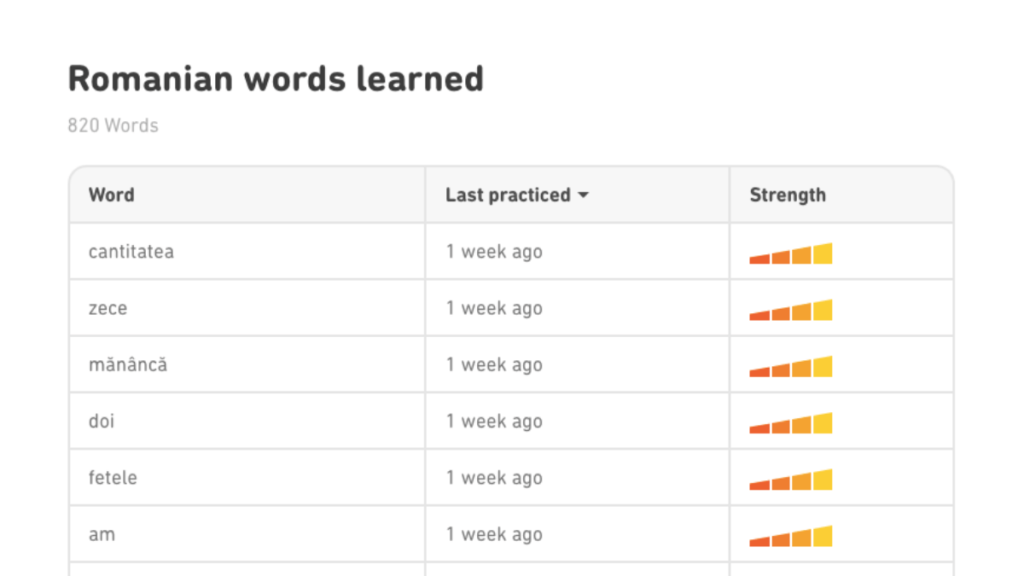
Duolingo breaks up the language into different topics and each topic will have a different focus. For example, some of the topics I learnt included food, animals, phrases, adjectives, numbers etc.
Below are some examples of words I learnt:
Woman, girl, boy, man, water, child, apple, bread, milk, rice, menu, letter, message, hello, thanks, yes, sorry, welcome, chocolate, honey, butter, sugar, dinner, dog, cat, mouse, good, easy, beautiful, old, hat, coat, one, two, three
Below are some examples of verbs I learnt:
To eat, to drink, to have, to speak, to read, to write, to sing, to help, to take, to ask, to open, to close, to decide, to sleep, to find, to sell, to start, to want, to appear, to like, to seem, to change, to buy, to hate
Below are some examples of phrases/sentences that I learnt:
I am a girl, I am not a man, I have children, you have a sandwich, two women have a newspaper and a book, a pie does not have butter, do you have honey?, we do not eat pork, the man reads the newspaper, the boy has hamsters, the child drinks two teas per day, the woman is tall and strong, the cake is on the table
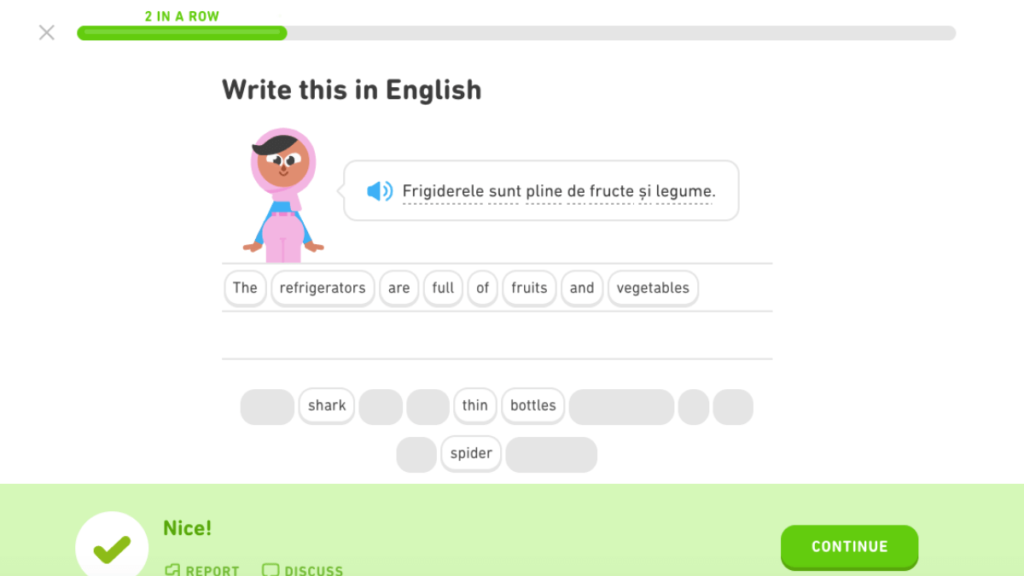
These are just a few examples of words, verbs and sentences that I learnt during my 30 days on Duolingo. There are plenty more things that I learnt in addition to these.
Duolingo Features & Teaching Style
Duolingo Romanian Course
The Duolingo Romanian course has 3 units with 62 different topics. Each topic contains 5 levels with between 2 and 9 lessons on each level.
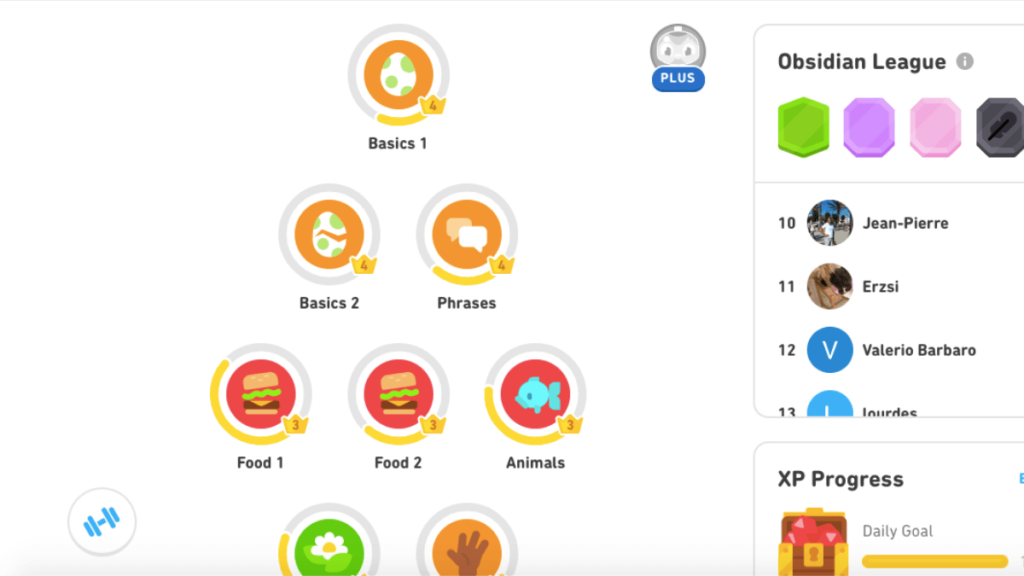
Tips
Each of the topics comes with a ‘tips’ page.
This is usually just a bit of information about what will be covered in the new lessons and usually explains the grammar points in more detail.
Overall I found that the tips pages were helpful. They often explained key grammar points included in lessons.
For example, on the first topic they included a pronunciation table which was useful and helped ensure I was pronouncing the letters correctly.
I did sometimes find that some grammar points were not explained.
For example, there are 2 interchangeable words used for he/she and in some examples they used one word whereas in other examples they used the other word.
This wasn’t explained by Duolingo so I became very confused. I had to look this up myself – I think Duolingo should really have explained confusing concepts like this.
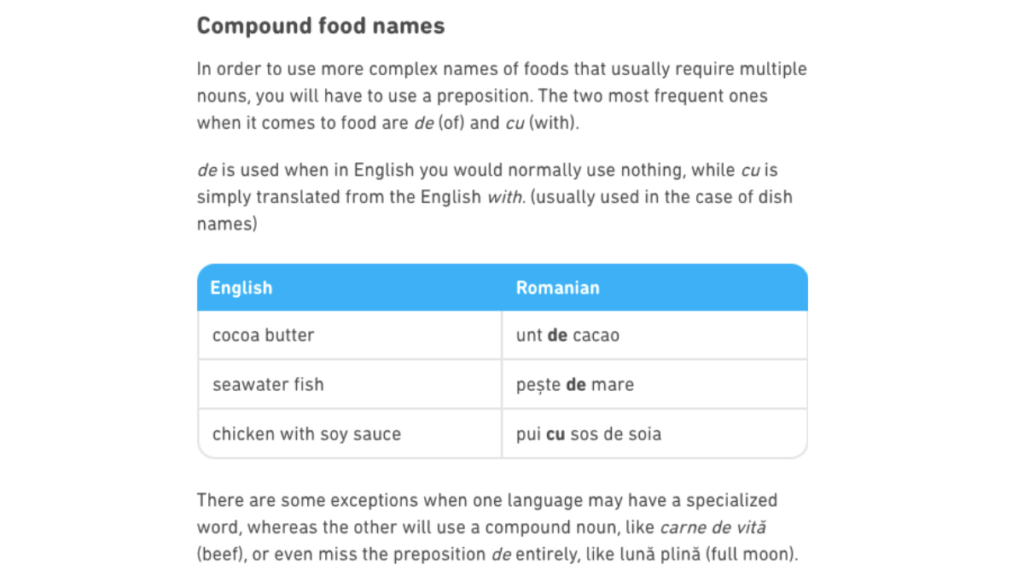
Stories
Stories are a feature of some Duolingo courses where you are given short stories to help your comprehension of the language.
Unfortunately the Romanian course doesn’t currently have any stories which is a shame because in the past I have found these super helpful when doing other Duolingo courses.
I think that stories are fantastic for improving your comprehension skills and would have been a useful feature.
Podcast/audio lessons
Unfortunately the Duolingo Romanian course doesn’t currently have any podcasts or audio lessons. They have introduced this as a feature on some courses but not on Romanian yet.
Teaching Style
When doing new lessons on Duolingo they tend to teach you new words/phrases by just asking you to select the correct meaning and showing you a picture to help.
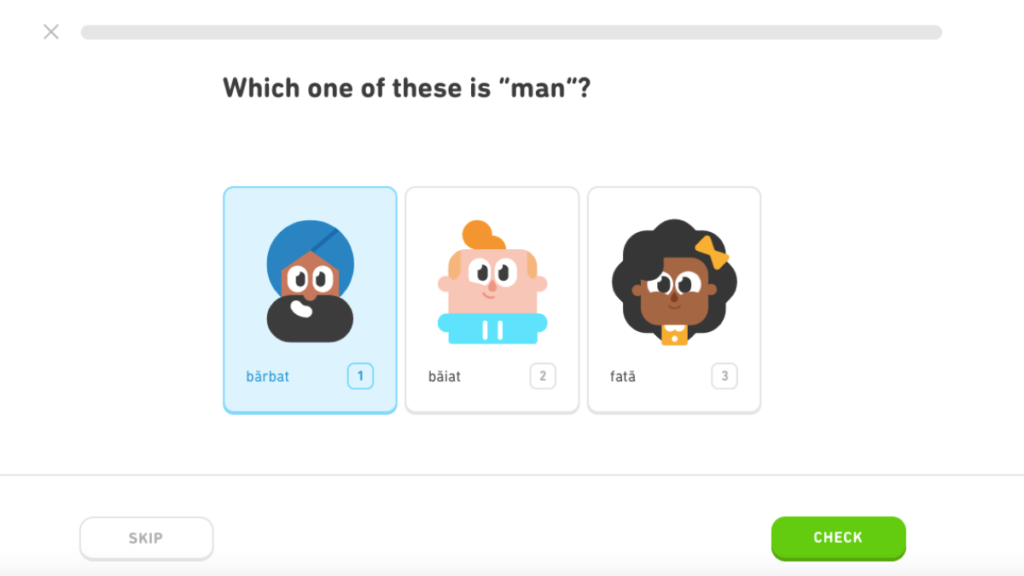
After that you get a range of exercises to practice including translating from English to Romanian and also from Romanian to English and also listening to words in Romanian and writing it in either Romanian or English.
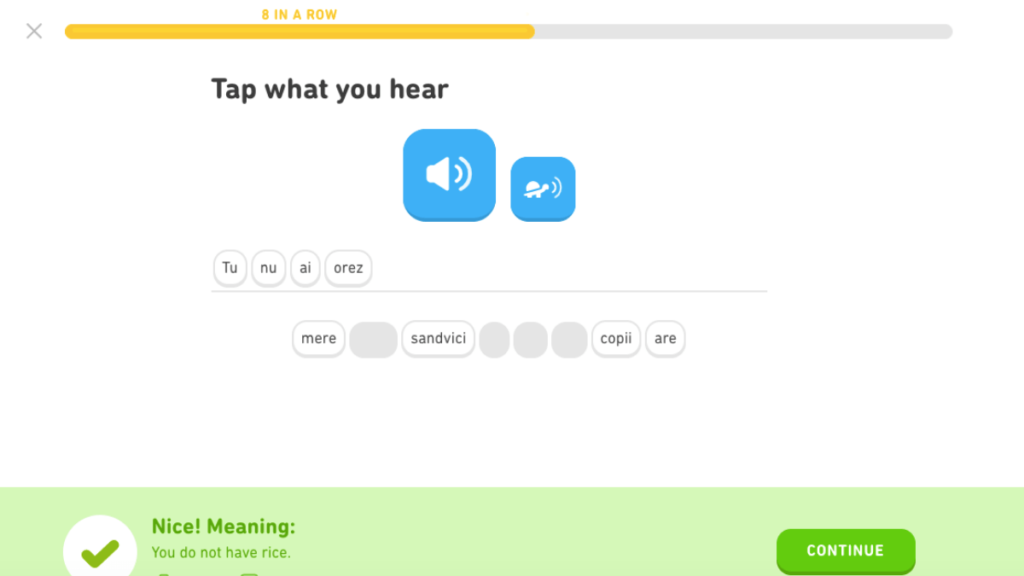
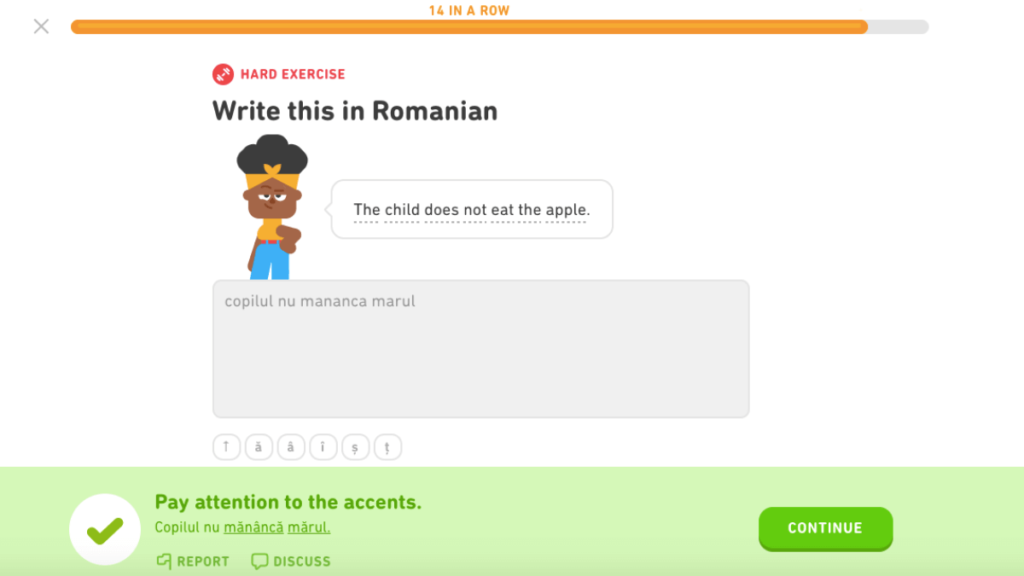
In each new lesson, Duolingo usually introduces a few new words and then uses these words in sentences that you’ve previously learnt in other topics so you can focus on learning the new words.
I did find that in some topics they taught a lot of new vocabulary words and in some instances it was too much. In some topics, we were taught 30 – 40 new words.
There wasn’t enough practice time in each lesson for you to learn the new words and then in the next lesson you were given lots more new words and by then you’ve already forgotten the others.
Duolingo needs to introduce new vocabulary a bit more slowly so you have time to learn them.
It would have been much better to introduce 10 – 15 new words in each topic and give students lots of time to practice and consolidate these words before moving on.
Speaking & Listening
Learning Pronunciation
The Duolingo Romanian course was good at teaching pronunciation of words.
Every single word and sentence included in the course has a sound clip to go with it so you can hear the correct pronunciation of the word/phrase.
The audio quality was fairly good but it did sound a bit robotic at times.
In one of the tips sections for one of the initial topics they included a pronunciation table which showed each letter in Romanian and the corresponding sound in English (they also included IPA as well). They gave example words too to make it easier. This was really helpful.
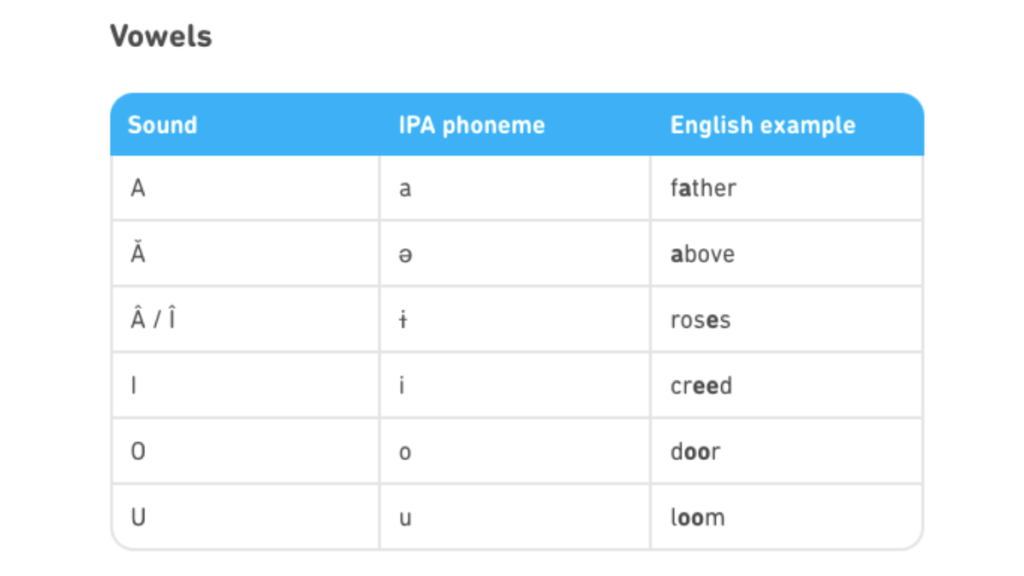
Tips Page For Pronunciation
I found that the more I practiced and the more lessons I did, the easier pronunciation became.
I didn’t spend ages studying the pronunciation chart, instead I did lots of lessons and to be honest the pronunciation just came naturally to me as I practiced more.
As you see more words and hear the pronunciation you pick up on the sounds and then when you see new words with the same letters you pronounce them correctly without hearing them first.
Voice Recognition
In some Duolingo courses they include voice recognition. This is where a word/phrase will appear on the screen and you have to say the word/phrase out loud into the microphone.
Duolingo will then tell you if you pronounced it correctly or not.
Unfortunately, the Duolingo Romanian course doesn’t include these types of exercises which is a shame because I have found them to be useful in the past when doing other Duolingo courses.
There’s not much opportunity to practice speaking when doing the Duolingo course so it’s a shame they didn’t include them as they really force you to speak out loud.
Fluency in Conversation
Fluency or being able to hold a conversation with someone in Romanian is probably one of the main reasons that anyone would choose to start the Duolingo Romanian course.
After doing the course for 30 days, I wouldn’t be confident at all in speaking with someone in Romanian.
Of course, after just 30 days there’s no way I would ever be at a fluent level but I’d even say that after this short time I wouldn’t be confident at all to say much more than some basic greetings and phrases.
One of the main negatives of the Duolingo Romanian course is that there isn’t much speaking practice. It’s all reading and writing.
The best way to practice speaking is to force yourself to say all the words/phrases out loud as they appear on the screen even if you don’t need to.
The more you say the words, the more they will be consolidated in your brain and they’ll come naturally to you later when you try to use them.
This is something that you will need to do for yourself though as Duolingo doesn’t ask you or require you to say the words out loud.
The lack of speaking practice means that I can’t confidently recall many of the words and phrases that I learnt during the course and say them.
I’m quite confident in recognising them when they appear in front of me but recall is much harder and that is the most important skill in being able to speak a language.
If speaking is your main goal then I’d suggest picking a Romanian course that focuses on speaking such as Pimsleur.
I’ve done Pimsleur courses in the past and they get you speaking from day 1 and only teach you useful phrases that you will actually use.
Listening Comprehension
The Duolingo Romanian course did include lots of listening exercises.
This is where they play you an audio clip of a word or phrase and you then have to try and write what was said.
There are no prompts other than just the audio clip so it forces you to listen.
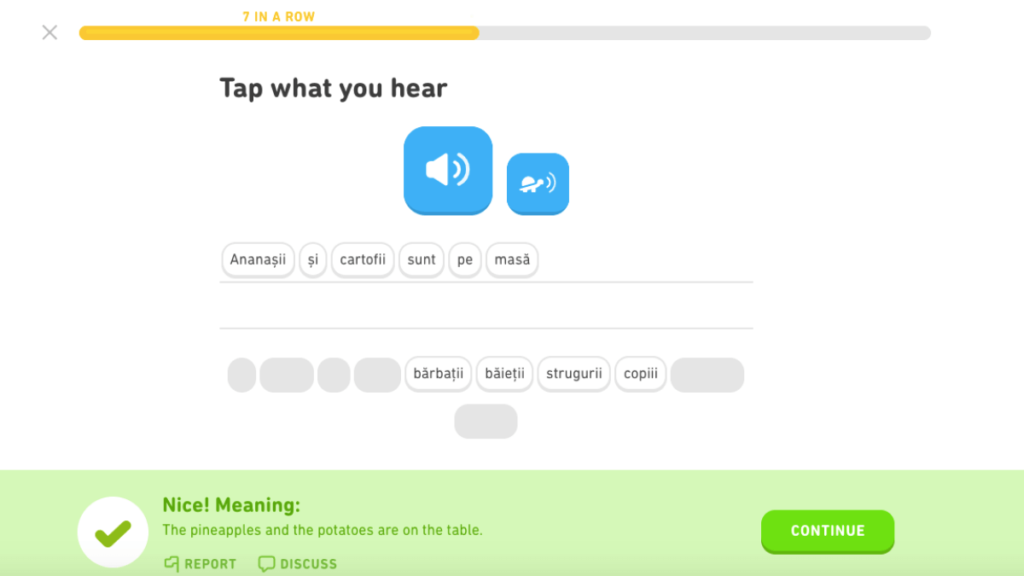
I found these listening exercises to be really effective as we often rely on the words on the screen when listening.
When we read and listen to a sentence at the same time we often think we are good at listening but then when we listen to it on it’s own it can be difficult to understand.
This is mainly because we get the understanding from the written words without realizing it.
For example, many people find that when watching a video/TV show in their target language with subtitles they can understand what is being said, however when they watch the same video/TV show without subtitles they struggle to understand it at all.
For this reason, I think the listening exercises are essential and I found them to be very beneficial to learning.
I don’t think you can successfully learn to listen to the Romanian language without this sort of practice.
Reading & Writing
Learning To Read The Script
Luckily, learning to read the Romanian script wasn’t very difficult as it uses mostly the same letters as English with just a few extra letters that have accents on them.
I didn’t really need much guidance on reading as it was very straightforward.
The tips section gave some good guidance on pronunciation and I mostly picked up pronunciation just from listening to the words/phrases.
Writing In Romanian
I found that writing in Romanian was fairly easy.
A lot of Romanian words were spelled as they sounded which was helpful.
I did have some trouble remembering some trickier words that had lots of accents but I got there in the end with lots of practice.
Duolingo often gives exercises where they give you an English word/sentence and ask you to type it in Romanian.
I found these to be challenging exercises at times but I do think they’re really important as you need to be able to recall the words.
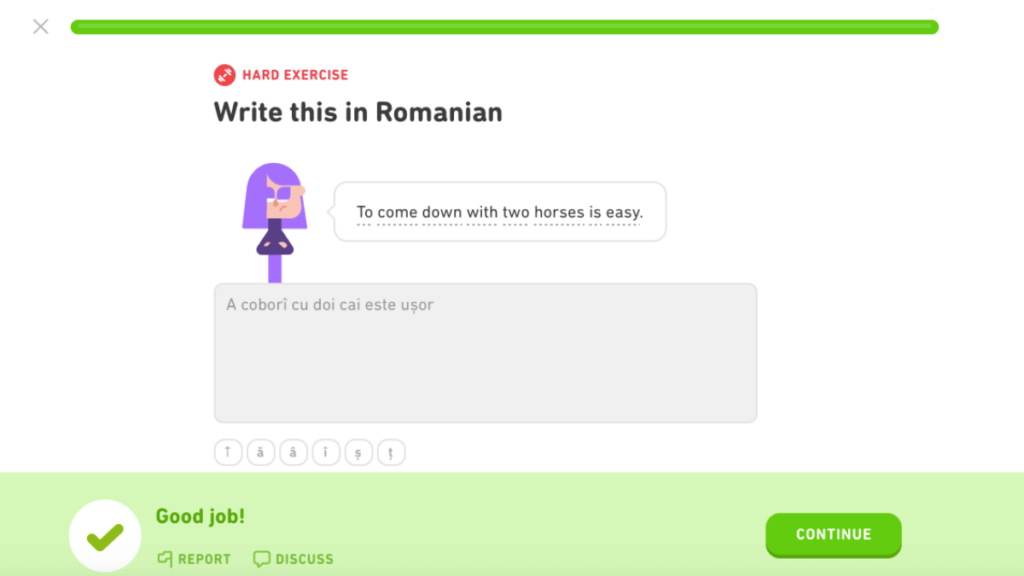
Of course as the Duolingo course is virtual, the writing practice mentioned here is actually typing practice – I still haven’t actually physically written any Romanian words with a pen yet. This is something you’d need to do in your own time if you wanted to practice it.
One negative point of the Duolingo course is that during these writing exercises, Duolingo accepts words that are written without the correct accents and sometimes with spelling errors.
As an example, ‘man’ in Romanian is ‘bărbat’ but Duolingo accepted ‘baibat’ as correct even though the accent on the ‘a’ was missing and I spelt the word wrong.
Whilst I understand why they have allowed this, I don’t think it actually helps learners because when writing or typing in real life they would need to use the correct accent marks and spellings.
It leads to learners not learning correct spellings which will hinder them in the future as they learn bad habits.
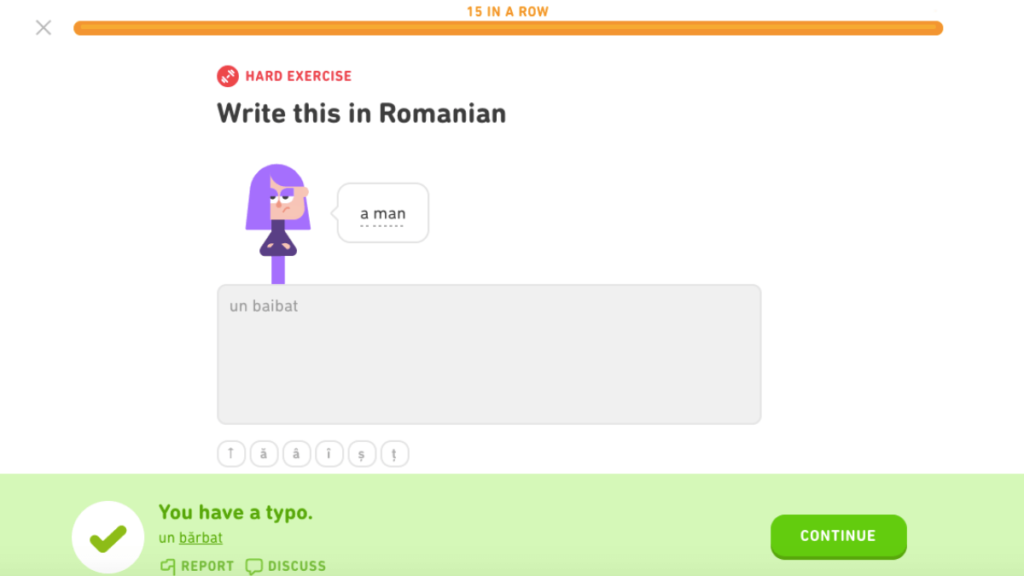
Verbs & Tenses Covered
Tenses are super important when it comes to learning a new language. After completing 30 days of the Duolingo Romanian course, I have only used the present tense.
I think it would have been nice to have learnt another tense, especially past tense as I would like to be able to discuss things that happened in the past.
Having said this, I can see that topics later in the course do introduce past tense so you’d have to do the course for longer to learn this.
Although I would have liked to have learnt some past tense, the course so far did include several different cases and some complex grammar points.
Cases – Cases are a grammatical concept where the ending of a noun or pronoun changes depending on the context.
I found the cases and grammar to be quite hard, so I think it was a good thing that Duolingo didn’t overload us with different tenses as well because the cases were hard enough.
Vocabulary Building And Relevancy
Overall I was happy with the vocabulary that Duolingo taught. Most of the vocabulary that was introduced to me was relevant and useful.
The first few lessons taught us words like boy, girl, man, woman, bread, milk.
After that each topic tended to focus on a particular vocabulary type e.g. there was a food topic that introduced lots of words like breakfast, lunch, tea, egg, salad etc.
I found that overall the words and phrases taught were relevant for a beginner.
There were some instances where I felt some words were not relevant for a beginner and could have been left out
e.g. in the animals topic we were taught how to say ox, canary, stallion, rooster, hen, seal.
It would have been better to stick to the key animals and build up other vocabulary before going into every animal ever.
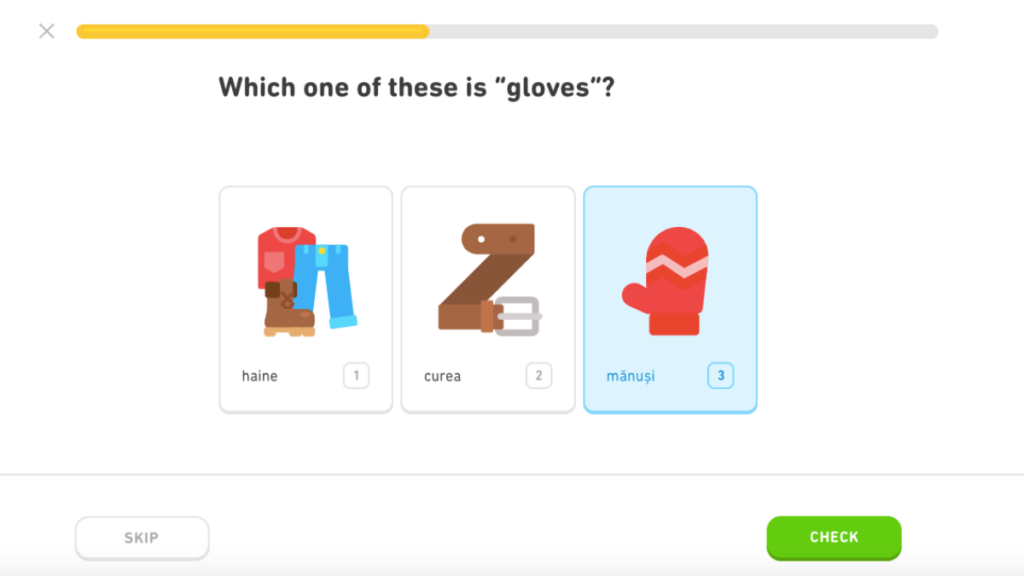
Memory/SRS
Being able to remember and recall words and phrases in Romanian is one of the most important things for a language learner.
Overall, I found that Duolingo tends to focus on reading more than anything else but they do put in plenty of exercises where you have to recall and type words and phrases from memory.
This is usually much harder than reading a phrase in Romanian and translating it into English.
I’d say I’m much better at reading in Romanian than writing/speaking Romanian as my recall isn’t as good as my recognition so it would have been good if Duolingo focused on this a bit more.
I also found that you have to have a plan on how you’re going to use Duolingo to ensure you don’t forget words that you’ve already learnt.
It’s up to you how long you spend on each topic before moving onto the next and it’s up to you to go back to previous topics and review them.
This can be difficult for a new language learner because after a while there’s tons of older topics that need reviewing.
This can be a problem because I can’t always remember when I last reviewed a particular topic and when’s the best time to review it again.
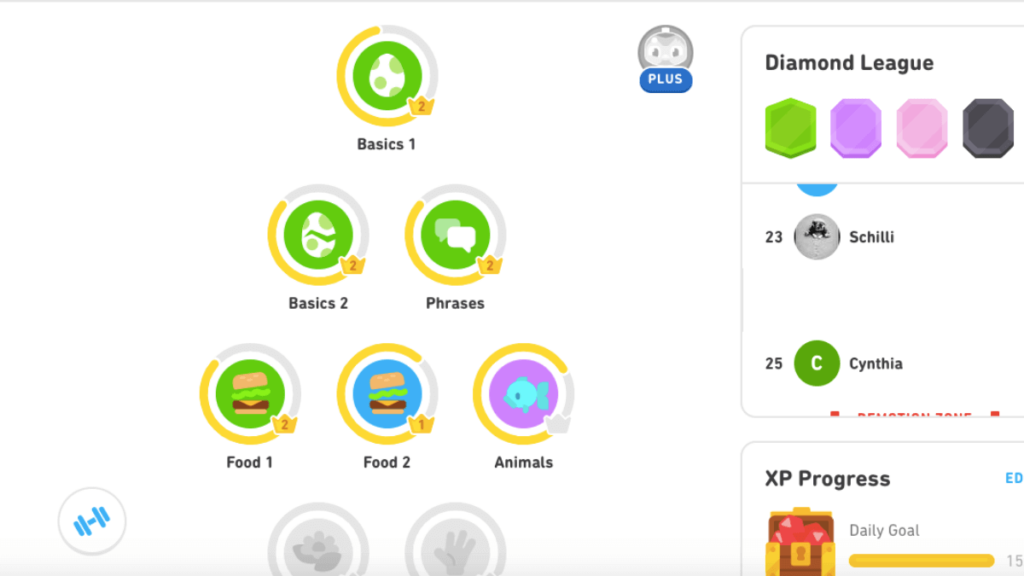
SRS or a spaced repetition system is best for this but Duolingo doesn’t really use SRS.
SRS is a method where a learner is asked to remember a certain word/phrase with the time intervals increasing each time the word is presented.
I think the Duolingo Romanian course could be improved by incorporating a more structured review process to ensure you don’t forget anything you learn in previous lessons.
Was It Fun?
One of the main positives of using something like Duolingo to learn a new language is that it is a gamified course.
They have lots of incentives that help you to come back everyday and do a few lessons.
These include the streak, where you build up a streak everyday that you do Duolingo.
They also have leaderboards where you compete against other people to build points and finish top of your league.
I found the actual course and content to be quite enjoyable, it’s not boring like reading a textbook.
The exercises are varied so you don’t get bored. I definitely think that it would be easy to keep up this routine and complete the entire course.
Overall Progression
Overall I am happy with the progress I made doing 30 days of Romanian on Duolingo.
In terms of the course progress I passed checkpoint 1 and covered 15 topics.
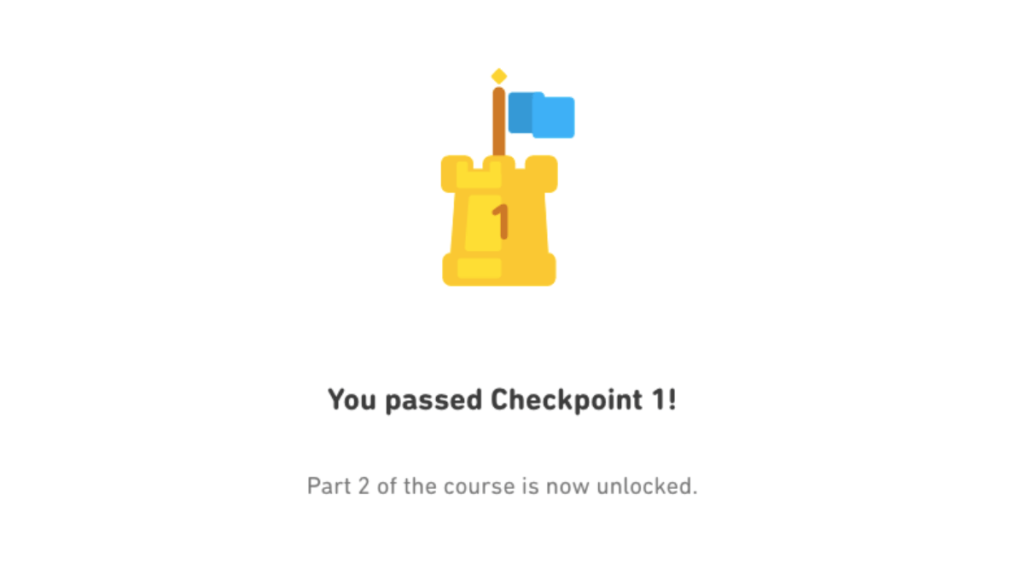
As an introduction to the language for a beginner, I think Duolingo does a good job of introducing some basic words, verbs, phrases and concepts.
They do introduce new concepts well.
There’s tons of practice so you can really become confident using the new words and phrases that you’ve learnt.
However, I found that some topics introduced too many words which made it hard to remember them.
As I mentioned before, I found that Duolingo wasn’t great for someone looking to speak the language as there’s basically no speaking practice.
If your main goal is to be able to speak then you’d be better with an audio course like Pimsleur.
If you’re serious about learning Romanian then I’d recommend trying the Pimsleur Romanian course for FREE before purchasing.
Can You Actually Learn The Romanian Language With Duolingo?
If you want to become fluent in Romanian then you won’t be able to do this with Duolingo alone.
Becoming fully fluent will require lots of different inputs including videos, books, audio lessons and much more.
Duolingo alone won’t get you there but as I said before it is a great introduction to the language.
Is Duolingo Romanian Worth It Or Is It A Waste Of Time?
Even though I don’t think you could become fluent in Romanian with Duolingo alone, I think it is worth doing especially if you are a beginner and have no prior knowledge of Romanian.
It does a good job of teaching you basic concepts, words and phrases and is fantastic in getting you used to the pronunciation and sounds of the language.
If your aim is to become a fluent Romanian speaker then it may be still worth doing the course as there’s lots of opportunity to practice and become exposed to the language.
It’s also Free!
However, I’d recommend doing another course such as Pimsleur alongside it as Duolingo has virtually no speaking practice.
Alternatives To Duolingo
There’s plenty of alternatives to Duolingo if you’re wanting to learn Romanian fluently.
My top recommendation is Pimsleur. This audio course will get you speaking from day 1 and has tons of content to build up your confidence and speaking level.
If you’re serious about learning Romanian then I’d recommend trying the Pimsleur Romanian course for FREE before purchasing.
RomanianPod101 is another great resource for someone looking to learn Romanian fluently.
They feature both audio and video lessons recorded by Romanian teachers who will explain everything to you in simple terms. They also have word lists and flashcards to help you study.
If you’re on a budget then RomanianPod101 has a great YouTube channel that covers lots of content and it’s free.
Check out one of their most popular videos below:
Thanks for reading this Duolingo Romanian review.
You’ll probably love this post on the best Romanian quotes and proverbs.
If you’re interested in learning more Romanian then check our other Romanian content here.
Related Posts:
